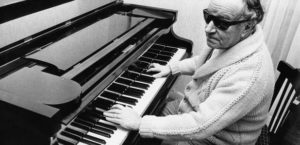Friday suggested listening: Paco De Lucia, Concierto de Aranjuez
Joaquín Rodrigo’s Concierto de Aranjuez is one of the most popular concertos of all time, one of the most original masterpieces of the 20th century.
Its beautiful central Adagio has been arranged for everything, from mouth, organ to brass band.
The piece
The Concierto de Aranjuez is a guitar concerto, written in 1939 by the Spanish composer Joaquín Rodrigo.
The piece was inspired by the gardens at Palacio Real de Aranjuez, the spring resort palace and gardens built by Philip II in the last half of the 16th century, and attempts the evocation of the sounds of nature.
According to the composer, the concerto itself as capturing
"the fragrance of magnolias, the singing of birds, and the gushing of fountains"
in the gardens of Aranjuez.
About the first movement, Rodrigo says:
"animated by a rhythmic spirit and vigour without either of the two themes... interrupting its relentless pace"
Regarding the second movement:
"represents a dialogue between guitar and solo instruments (cor anglais, bassoon, oboe, horn etc.)"
The last movement
"recalls a courtly dance in which the combination of double and triple time maintains a taut tempo right to the closing bar."
The author
Joaquín Rodrigo was a native of Sagunto, on Spain’s Mediterranean coast.
He was affected by diphtheria when he was still a small child and, despite several operations, he soon lost sight completely.
This handicap did not prevent him vigorously pursuing a career in music, in which he showed a keen interest from a very early age, starting as student at the Valencia Conservatoire from the age of 8, and becoming soon an accomplished pianist.
 Rodrigo has been head of the Artistic Section of the Spanish National Organisation for the Blind, Professor of Music History at Complutense University, Madrid, and head of music broadcasts for Spanish Radio.
Rodrigo has been head of the Artistic Section of the Spanish National Organisation for the Blind, Professor of Music History at Complutense University, Madrid, and head of music broadcasts for Spanish Radio.
He was also an active critic, writing for several newspapers. He travelled widely as a cultural ambassador for Spanish music, and received many honours both in Spain and internationally.
In addition to Concierto de Aranjuez and his other guitar concertos (including concertos for both two and four guitars) he wrote concertos for violin, for cello, for piano, for flute, for harp. He also composed choral works, symphonic poems, songs, chamber and piano music and arrangements of older Spanish music.
Paco de Lucia’s "flamenco version"
The Paco de Lucia version is definitely different from standard classical versions: his flamenco sensibility fits the music's idiom well even though it was written as classical music and captures its spirit like no other.
The playing is passionate, fresh and utterly authentic.
https://open.spotify.com/album/3kYhw19SFaOanazThWHgK8
However, i'd like to share an opinion by M. Angelo Gilardino, on Delcamp forum:
The version of Paco de Lucia should be listened to for what it is, a flamenco version of the Concierto, not a classical interpretation. Paco de Lucia did not read the music in notation, he learned the concert by imitation from a classical guitarist (José Maria Gallardo del Rey), not from the text, so it can not be put on the same level as the interpreters who read.
https://www.youtube.com/watch?v=RhO5OSLZjl8